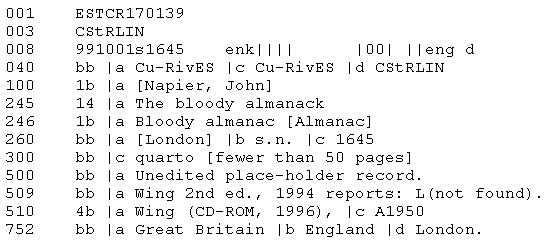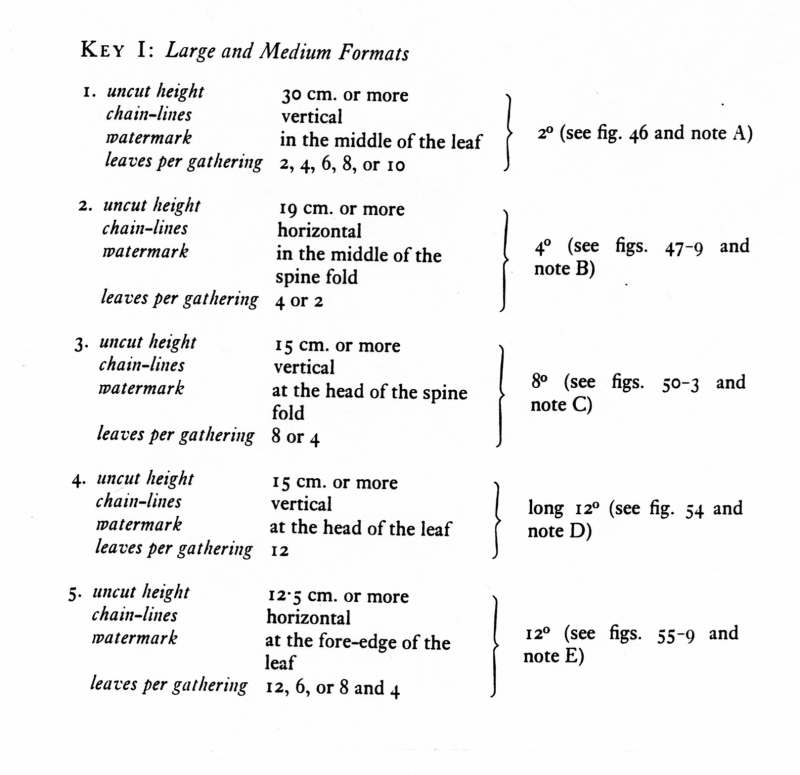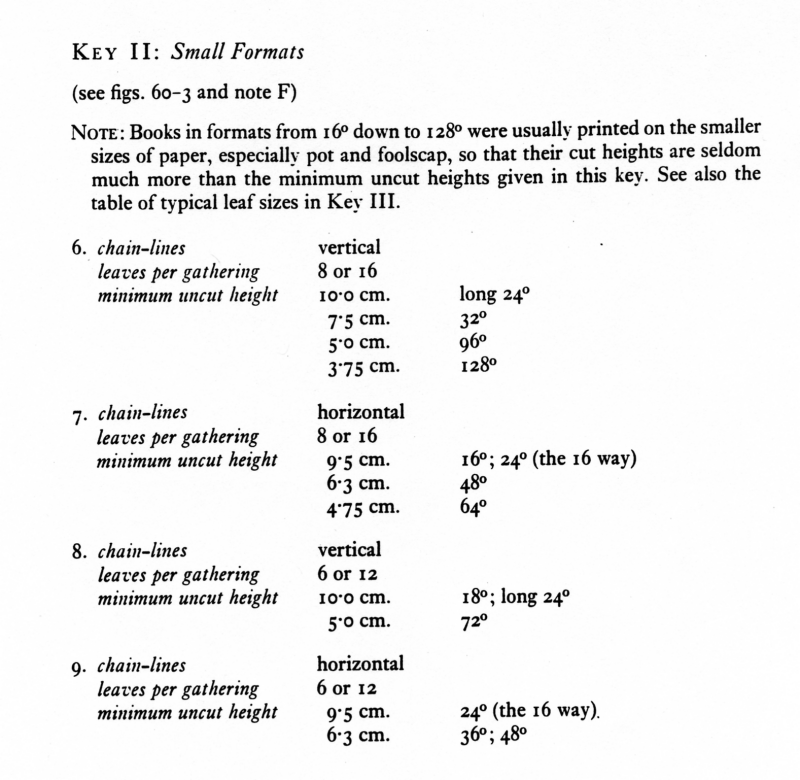Matching Criteria
Types of records in the database
Verified vs. unverified matches
- Uncomplicated match to an edited record
- Matching to an edited record, with a Cataloguer’s Note
- Matching to an unedited record
- Matching to a partial record
- No match to a record with a Cataloguer’s Note
- No match to any record
Types of records in the database
There are four types of records in the ESTC database.
Edited Records
Edited records represent the book as a whole, with the complete title (minus extraneous quotes and scriptural references), imprint, pagination, format, and, sometimes, an internal description of the book.
18th century records
18th century records were created according to the cataloging rules of the Eighteenth Century Short Title Catalogue and omit most of the title and, in the imprint, the printer’s and publishers’ addresses. There are no partial or unedited 18th century records. Please note also for 18th century records:
- Punctuation following the printers’ and publishers’ names in the imprint field is the punctuation at the end of the printers’ or publishers’ address.
- If a large number of printers or publishers are present, the names at the end of the imprint may be replaced with "[and [#] others]".
- Roman numeral dates are almost always given, silently, as Arabic.
- Pagination does not include blank leaves, or the number of plates, when present.
The record above silently omits the printers' addresses seen in the title page below and uses Arabic and not Roman numerals for the date.
Unedited and partial records
Unedited and partial records are atypical of the database and require special attention. These records are batch-loaded records incorporated into the ESTC database and are in the process of being upgraded. These records are only found in the STC (1473-1640) and Wing (1641-1700) periods.
- Unedited records may omit words silently from the title and use ISBD punctuation. They lack printers’ and publishers’ addresses in the imprint and sometimes give Roman numeral publication dates as Arabic. Pagination often lacks preliminary or final leaves and format is never recorded. These records sometimes supply an edition statement from an outside source without so noting. The primary library holding is either umi or oclc (this can be seen in the Holdings Display).
- Partial records have titles as per Wing CD-Rom, 1996 and STC file entries and omit much of the title. Imprints often lack printers’ and publishers’ addresses and Roman numeral publication dates are sometimes given in Arabic. The pagination is absent in most cases, but the format is present either numerically or spelled out.
Return to the top of the page.
Verified vs. unverified matches
Matches are of two kinds: verified and unverified. It is assumed that any matching done with a book in hand will result in a verified match.
To be a Verified match, the book in hand must correspond to edited records exactly in the following fields, and to 18th century records within the limits of 18th century cataloging conventions:
- Title: title proper should match exactly with regard to spelling and punctuation.
- Edition: edition statements may be found within the text of the title or following it and must match exactly with regard to spelling and punctuation.
- Imprint: if an element of the imprint is taken from another source or from another position within the imprint, it is enclosed within brackets. The first element of the imprint field is the place of publication followed by a space and a colon. The last element contains the date of publication and is always preceded by a comma. All else is contained in the second element of the imprint field and should match exactly with regard to spelling and punctuation.
- Pagination: matches may be made in conjunction with reporting, in the Copy Notes field, any imperfections of the book in hand (See Copy Notes and Provenance.)
- Format: format refers to the imposition of the type and resultant folding of the paper on which the text was printed. This is determined from the evidence of watermarks, number of leaves per gathering, chainlines and size. For detailed information see Gaskell's A New Introduction to Bibliography:
- Large and Medium Formats
- Small Formats
- General notes: when a general note pertains to variants in title, (imprint, pagination, etc.) differing text settings, and other details with regard to edition, it is very important to compare these notes with the book in hand to complete a match.
Return to the top of the page.
Types of matches
For a given book, the matcher may take one of six actions.
An uncomplicated match to an edited record.
Absolutely everything corresponds to the book in hand or can be accounted for. The item is matched with a status of verified.
Matching to an edited record, with a Cataloguer’s Note.
Instances where a Cataloguer’s Note is called for:
- Everything matches except for a typo in the title or imprint.
- There is a break in the pagination not accounted for in the record.
- The book in hand has an additional preliminary or final leaf not acknowledged in the record.
- Everything matches in the title, imprint, and pagination, but one of the general notes does not describe the book in hand (i.e. describes another edition or a variant).
- There is more than one record your copy can match, so an additional general note is needed to further differentiate the records.
- Something looks weird.
Please note that if your query needs an immediate response, it is best to contact the ESTC catalogers at estc-catalog@cbsr.ucr.edu.
Matching to an unedited record.
DO NOT MATCH TO AN UNEDITED RECORD
Unedited records are in the process of being upgraded. Preference is given to those unedited records to which a contributing library wishes to match items. Email the ESTC catalogers at estc-catalog@cbsr.ucr.edu if you find an unedited record to which you need to match.
Matching to a partial record.
DO NOT MATCH TO A PARTIAL RECORD
There is no way to update partial records without a report from a contributing library. Report your holding as if reporting for a new record. Include the ESTC identification number of the partial record on the report. See Reporting Procedures for more information on reporting partial records to the ESTC.
No match to a record with a Cataloguer’s Note.
Exceptionally, the matcher will find more than one possible record to match to, and the general notes they contain are either contradictory or insufficient to permit narrowing the choice to one. The matcher may enter an unverified match with a Cataloguer’s Note in one of the records, explaining the problem. ESTC will resolve the problem to permit a match, sometimes requiring additional information from the contributing library. Again, for a more immediate response, email the ESTC catalogers at estc-catalog@cbsr.ucr.edu.
No match to any record in the database
If the item in hand does not match anything in the database, the matcher should report the item to ESTC as a new record. See Reporting Procedures for more information on reporting new records to the ESTC.






